Apple's 15-inch Core i5 MacBook Pro: The One to Get?
by Anand Lal Shimpi on April 14, 2010 10:38 PM EST- Posted in
- Mac
- MacBook Pro
- Arrandale
- Core i5
- Laptops
They’re Actually Faster
Benchmarking under OS X isn’t difficult, you just need to get creative. Luckily I’m in dire need of creative outlets so creating OS X benchmarks works for me. I’m using the same tests I introduced in my Holiday 2009 Macbook Pro roundup and running on the same hardware (specs listed in the tables on the previous pages). The Core i5 system is the new entry level 15-inch MacBook Pro.
We’ll start with general application performance.
General OS usage is a difficult thing to quantify, but one measure of performance has always been the number of bounces an icon in the dock makes before an application loads. I decided to take it to the next level and write a quick script to launch 15 applications in a row, timing how long the entire process takes.
I launched, in order: Mail, Safari, Activity Monitor, iTunes, iCal, DVD Player, iPhoto, Photo Booth, Quicktime Player, Disk Utility, Preview, iMovie, Front Row, Garage Band and Aperture.
The entire process stresses both the disk and CPU, which is why we see a huge improvement when going to an SSD as well as differences between CPU speeds.
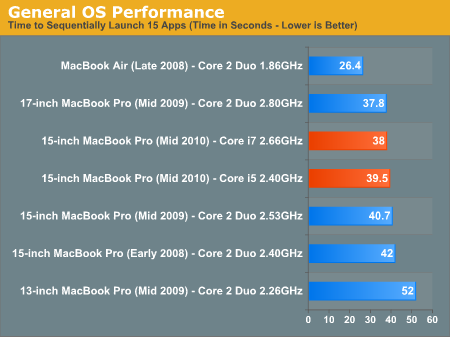
My application launch test absolutely rocks on the MacBook Air because it ships with an SSD by default. The MacBook Pros are stuck with mechanical hard drives and thus don’t perform nearly as well. If you’re curious, installing an Intel X25-M G2 in any of the MBPs will drop their times to 16 seconds or less.
The new MacBook Pro also doesn’t improve performance that much. I measured a 3% increase in performance, which although repeatable, isn’t really spectacular. This is compared to the old 2.53GHz Core 2 Duo and should serve as a baseline for the minimum performance improvement you should see. In other words, the 2.4GHz 15-inch MacBook Pro should perform no worse than last year’s 2.53GHz model.
The $2199 model with a Core i7 running at 2.66GHz pushes performance up another 3.9% over the base model. That's actually more than I expected but the real strength of the i7 is visible in the more CPU bound tests.
Adobe Photoshop CS4 Performance
The Retouch Artists Speed Test we use for our CPU testing under Windows also works under OS X. We're running the exact same benchmark here, basically performing a bunch of image manipulations and filters and timing the entire process.
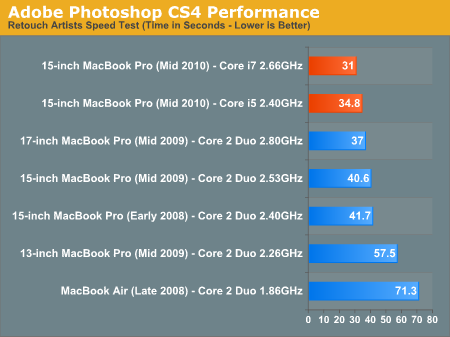
The old 13-inch MacBook Pro is penalized by only shipping with 2GB of memory, which is why it performs so poorly here. The real comparison is between the 2.4GHz Core i5 vs. the 2.53GHz Core 2 Duo from last year. The former is 16.6% faster in our Photoshop test. In fact, the new 15-inch MacBook Pro is even faster than the older 2.80GHz 17-inch model I reviewed.
The Core i7 model is 12.3% faster than the baseline Core i5 2.40GHz. Definitely noticeable.
Aperture 2 RAW Import
For my Aperture test I simply timed how long it took to import 203 12MP RAW images into the library.
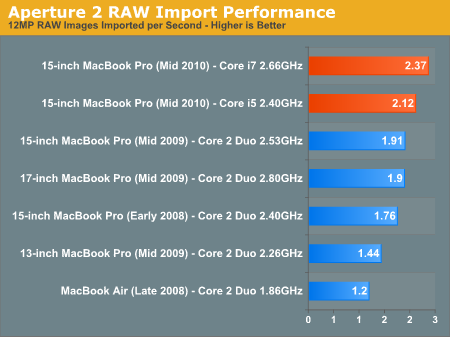
The new entry level 15-inch MBP is 10.9% faster than the old MacBook Pro, and again, it’s faster than the old 17-inch model as well. Moving to the Core i7 gives you another 11.8%.
Cinebench R10
I’m a fan of the Cinebench test because it lets me show off both single and multithreaded performance in the same workload. First, the single threaded performance:
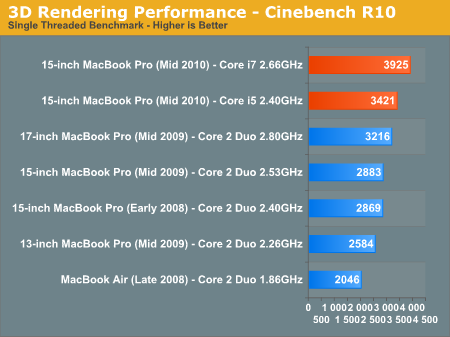
Here we have a huge advantage on the new MacBook Pro. Intel’s Turbo Boost is active here, resulting in a large performance advantage, not to mention all of the enhancements present in the Nehalem/Arrandale architectures. This is one of the best situations for the Core i7 vs. the i5. The extra $400 gives you another 14.7%, not bad at all.
Multithreaded performance is equally impressive:
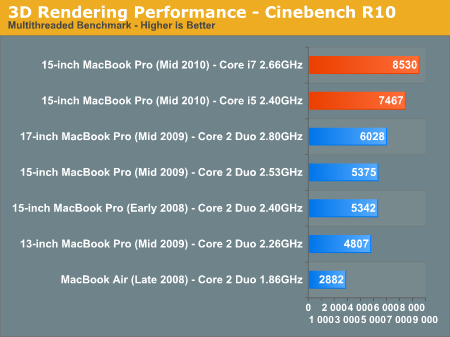
Thanks to Hyper Threading, the new Core i5 puts a generational gap between itself and last year’s MacBook Pro in this test. Whether you’re running single threaded or multithreaded applications, the Core i5 can be noticeably faster than the Core 2 Duo.
Quicktime H.264 Video Encoding
Our final benchmark is more consumer focused. Here I'm taking an XviD and converting it to an iPhone-supported H.264 format.
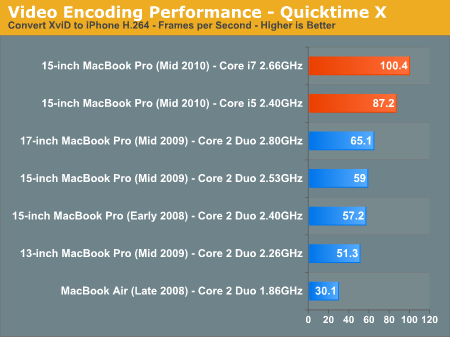
Video encoding is one of the i5’s definite strengths. If you do a lot of video encoding on your notebook, the jump from Core 2 to i5 is tremendous - approaching 50% in this case even despite the “lower” default clock speed. This is also the best showing for the Core i7 - count on an extra 15% over the base Core i5.
Core i7 vs. Core i5 Performance Summary
The two Core i5 models Apple offers ship with a 2.40GHz or 2.53GHz processor, both with a 3MB L3 cache. The $2199 15-inch MacBook Pro comes with a 2.66GHz Core i7, with a full 4MB L3 cache. Compared to the entry level model that's an 11% increase in clock speed and a 33% increase in L3 cache.
While I don't believe there's much reason to go for the 2.53GHz over the 2.40GHz model (L3 cache size remains the same, clock speed goes up by a small amount), the Core i7 is actually pretty decent. For a 22% increase in total system cost you end up with 11 - 15% better performance in CPU bound applications. It actually even feels snappier in general use as well.
I'd still suggest opting for an SSD before considering any CPU upgrades, but if you're looking to keep your new MacBook Pro for a while the Core i7 is worth it.










114 Comments
View All Comments
The0ne - Thursday, April 15, 2010 - link
Wait, huh? I run Win7 and have XP and redhat and ubuntu running. Why can't he do the same? I'm totally confused. So it's meant to be MacOS only?jasperjones - Thursday, April 15, 2010 - link
I said primary OS, not "only" or "exclusive" OS. It's well-known, for example, that MBPs has some issues on Windows that they don't have on OS X. My point is if you don't plan on running OS X most of the time, get something different.Anand wrote:
"You're paying for the design, build quality and ultimately the right to use OS X. If those things don't matter to you (particularly the OS X item) then you'd be much better off with an ASUS or Dell."
I would assume he made that comment in similar spirit.
mikeev - Thursday, April 15, 2010 - link
What's wrong with at least him testing Win7 battery life and letting us know? Is it some sort of secret? We know it's going to be bad- we just want to know how bad.I swear, fanboys sometimes... *facepalm*
Anand Lal Shimpi - Friday, April 16, 2010 - link
If I get the time to I'll run some Windows 7 numbers on it for you guys :)Take care,
Anand
mikeev - Friday, April 16, 2010 - link
Thanks Anand!!Jimbo - Thursday, April 15, 2010 - link
Why not just get your own Intel 80GB SSD and call it a day?I think that 15" I5 with an SSD would would be about as much speed as anyone could reasonably want from a notebook these days.
damianrobertjones - Thursday, April 15, 2010 - link
Has Anand every reviewed or posted about the HP Envy? Just asking as I'd hate this all to be about applePhynaz - Thursday, April 15, 2010 - link
You would hate a Mac article to be just about Apple?Yeah, that makes sense.
sportherz - Thursday, April 15, 2010 - link
Thanks alot for the great update! However, I was wondering if you have any information on the new 13inch MacBookPro. I was looking to upgrade from an older ThinkPad T61p to the new 13 inch MacBookPro, mainly because I hate the time it takes my ThinkPad to wake (running it in Windows 7, using a Vertex SSD) and more importantly the battery life. Due to having to fly often I was also not happy with a 15inch notebook and thus I was eyeballing the 13inch. It would be great if you could post some benchmarking on the 13inch graphics card. It seems that from general performance alone there is really no need to go to the arandale (4% increase in speed seems marginal), is that true? Thus would you second Steve Job's saying that the more important upgrade was the graphic chip?Any additional info would be greatly appreciated!
Thanks for doing such an excellent job!
fsardis - Thursday, April 15, 2010 - link
do the edges still cut through your wrists as you type?does it still get too hot to touch when doing any sort of intensive task?
does the screen still tip over the moment you tilt the laptop forward in your lap?
i wonder why i never see these obvious design flaws mentioned.